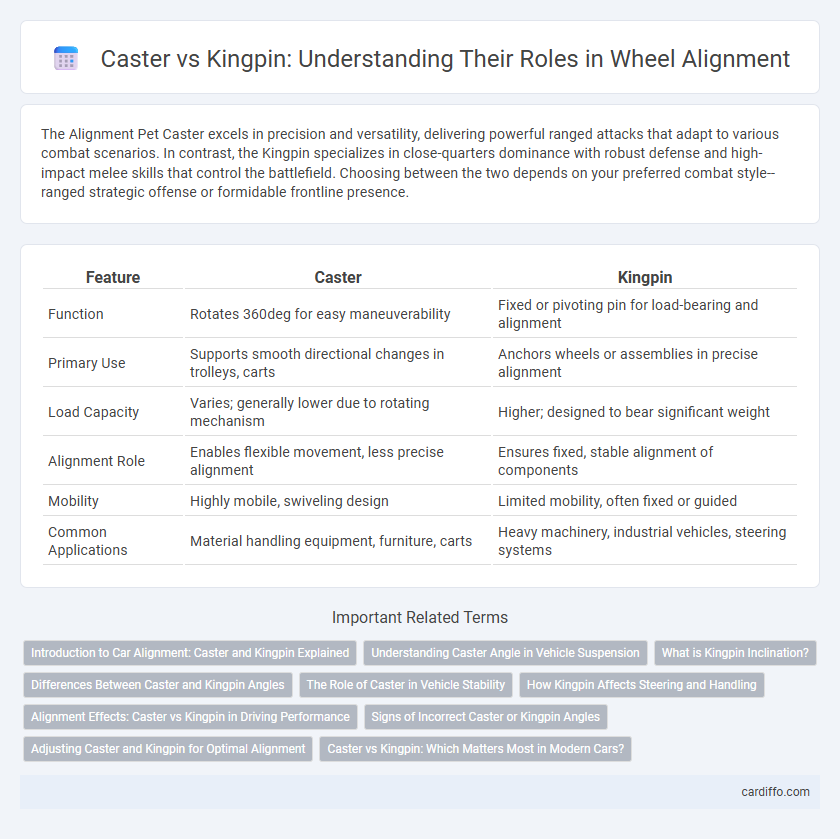The Alignment Pet Caster excels in precision and versatility, delivering powerful ranged attacks that adapt to various combat scenarios. In contrast, the Kingpin specializes in close-quarters dominance with robust defense and high-impact melee skills that control the battlefield. Choosing between the two depends on your preferred combat style--ranged strategic offense or formidable frontline presence.
Table of Comparison
| Feature | Caster | Kingpin |
|---|---|---|
| Function | Rotates 360deg for easy maneuverability | Fixed or pivoting pin for load-bearing and alignment |
| Primary Use | Supports smooth directional changes in trolleys, carts | Anchors wheels or assemblies in precise alignment |
| Load Capacity | Varies; generally lower due to rotating mechanism | Higher; designed to bear significant weight |
| Alignment Role | Enables flexible movement, less precise alignment | Ensures fixed, stable alignment of components |
| Mobility | Highly mobile, swiveling design | Limited mobility, often fixed or guided |
| Common Applications | Material handling equipment, furniture, carts | Heavy machinery, industrial vehicles, steering systems |
Introduction to Car Alignment: Caster and Kingpin Explained
Caster refers to the angle of the steering axis pivot when viewed from the side of the vehicle, which influences straight-line stability and cornering performance. Kingpin is the pivot around which the steering rotates, typically measured by the kingpin inclination angle affecting steering effort and returnability. Understanding the relationship between caster and kingpin angles is essential for optimizing vehicle handling, tire wear, and overall alignment accuracy.
Understanding Caster Angle in Vehicle Suspension
Caster angle in vehicle suspension refers to the tilt of the steering axis when viewed from the side, typically measured in degrees. Unlike kingpin inclination, which affects steering effort and camber gain, caster angle primarily influences straight-line stability and steering wheel returnability. Proper understanding and adjustment of caster angle enhance vehicle handling performance and driver control during cornering and directional changes.
What is Kingpin Inclination?
Kingpin inclination refers to the angle formed between the vertical axis of the steering pivot and the vertical axis of the wheel when viewed from the front of the vehicle. This alignment parameter improves steering stability and helps the wheels return to the straight-ahead position after a turn. Proper kingpin inclination reduces tire wear and enhances handling by minimizing steering effort and increasing directional control.
Differences Between Caster and Kingpin Angles
Caster angles measure the tilt of the steering axis from vertical, affecting vehicle stability and steering effort, while kingpin angles refer to the inclination of the steering pivot points on the suspension, impacting steering responsiveness and tire wear. The caster angle typically ranges between 2 to 6 degrees positive to provide directional stability, whereas kingpin angles vary based on suspension design and are crucial for proper camber change during steering. Understanding the distinct roles of caster and kingpin angles ensures optimum handling, alignment settings, and reduced tire degradation.
The Role of Caster in Vehicle Stability
Casters play a critical role in vehicle stability by influencing directional control and steering responsiveness, typically found in the suspension or steering systems. Positioned to create a pivot point, casters help maintain straight-line tracking and improve handling by providing self-centering forces that guide wheels back to the forward position. In contrast, kingpins serve as the main vertical axis for steering movement, making casters essential for dynamic alignment and overall vehicle stability.
How Kingpin Affects Steering and Handling
Kingpin angle directly influences steering precision and vehicle handling by determining the pivot point for wheel rotation. A steeper kingpin angle enhances straight-line stability but may reduce responsiveness in tight turns. Adjusting the kingpin geometry optimizes camber gain during cornering, improving tire contact and overall control.
Alignment Effects: Caster vs Kingpin in Driving Performance
Alignment effects on driving performance vary significantly between caster and kingpin angles. Proper caster angle enhances straight-line stability and steering feedback, reducing driver fatigue and improving control during high-speed driving. In contrast, kingpin alignment primarily affects steering effort and tire wear, where incorrect angles can lead to uneven tire wear and increased steering resistance, negatively impacting overall vehicle handling.
Signs of Incorrect Caster or Kingpin Angles
Incorrect caster angles often cause uneven tire wear and poor straight-line stability, while improper kingpin angles result in excessive steering effort and premature suspension component wear. Signs include vehicle pulling to one side, unstable steering return, and unusual tire feathering patterns. Measurement of caster and kingpin angles using alignment tools is essential to pinpoint deviations and ensure optimal handling performance.
Adjusting Caster and Kingpin for Optimal Alignment
Adjusting the caster and kingpin angles is crucial for optimizing vehicle alignment, directly affecting steering stability and tire wear. Increasing caster angle enhances straight-line stability and steering feedback, while proper kingpin inclination reduces scrub radius, improving cornering precision. Precise calibration of both caster and kingpin ensures balanced alignment, maximizing handling performance and extending tire life.
Caster vs Kingpin: Which Matters Most in Modern Cars?
Caster and kingpin angles both critically affect a vehicle's steering stability and handling precision, but caster angle often plays a more dominant role in modern cars due to its influence on straight-line tracking and steering self-centering. Kingpin angle impacts steering effort and tire wear but is typically complemented by advanced suspension designs that mitigate its drawbacks. Prioritizing proper caster alignment optimizes vehicle control and improves ride comfort, making it a key factor in modern automotive alignment setups.
Caster vs Kingpin Infographic

 cardiffo.com
cardiffo.com